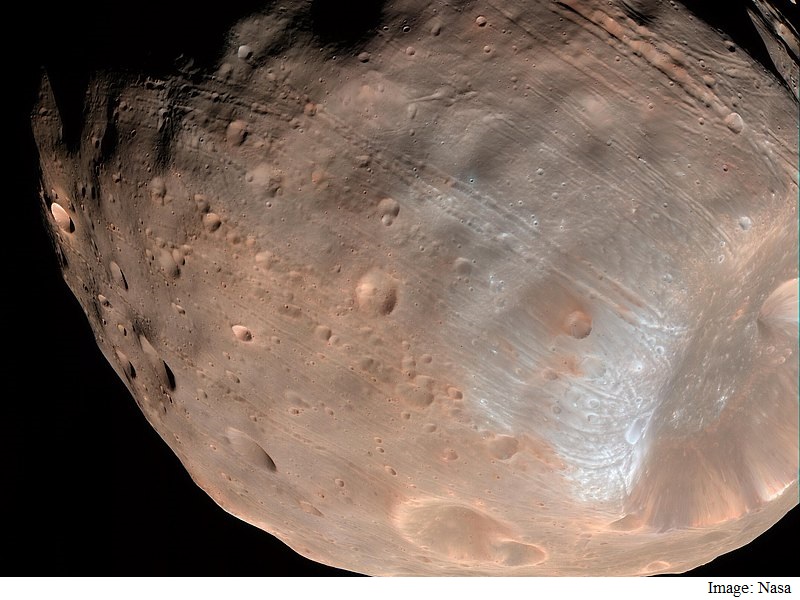- Home
- Science
- Science News
- Mars' Moon Phobos Is Slowly Falling Apart: Study
Mars' Moon Phobos Is Slowly Falling Apart: Study

The long, shallow grooves lining the surface of Phobos are likely early signs of the structural failure that will ultimately destroy this moon of Mars.
Orbiting a mere 6,000 km above the surface of Mars, Phobos is closer to its planet than any other moon in the solar system.
Mars' gravity is drawing in Phobos, the larger of its two moons, by about 6.6 feet every hundred years.
Scientists expect the moon to be pulled apart in 30 to 50 million years.
"We think that Phobos has already started to fail, and the first sign of this failure is the production of these grooves," said Terry Hurford from Nasa's Goddard Space Flight Center in Greenbelt, Maryland in a statement.
More recently, researchers proposed that the grooves may instead be produced by many smaller impacts of material ejected from Mars.
But new modeling supports the view that the grooves are more like "stretch marks" that occur when Phobos gets deformed by tidal forces.
The gravitational pull between Mars and Phobos produces these tidal forces.
Earth and our moon pull on each other in the same way, producing tides in the oceans and making both planet and moon slightly egg-shaped rather than perfectly round.
The same fate may await Neptune's moon Triton, which is also slowly falling inward and has a similarly fractured surface. The work also has implications for extrasolar planets, according to researchers.
Get your daily dose of tech news, reviews, and insights, in under 80 characters on Gadgets 360 Turbo. Connect with fellow tech lovers on our Forum. Follow us on X, Facebook, WhatsApp, Threads and Google News for instant updates. Catch all the action on our YouTube channel.
Related Stories
- Samsung Galaxy Unpacked 2025
- ChatGPT
- Redmi Note 14 Pro+
- iPhone 16
- Apple Vision Pro
- Oneplus 12
- OnePlus Nord CE 3 Lite 5G
- iPhone 13
- Xiaomi 14 Pro
- Oppo Find N3
- Tecno Spark Go (2023)
- Realme V30
- Best Phones Under 25000
- Samsung Galaxy S24 Series
- Cryptocurrency
- iQoo 12
- Samsung Galaxy S24 Ultra
- Giottus
- Samsung Galaxy Z Flip 5
- Apple 'Scary Fast'
- Housefull 5
- GoPro Hero 12 Black Review
- Invincible Season 2
- JioGlass
- HD Ready TV
- Laptop Under 50000
- Smartwatch Under 10000
- Latest Mobile Phones
- Compare Phones
- Realme P4x 5G
- OnePlus Ace 6T
- OPPO A6x 5G
- Samsung Galaxy Z TriFold
- Poco F8 Ultra
- Poco F8 Pro
- Huawei Mate 80 RS Master Edition
- Huawei Mate 80 Pro Max
- Asus ProArt P16
- MacBook Pro 14-inch (M5, 2025)
- Poco Pad M1
- Poco Pad X1
- Just Corseca Skywatch Pro
- Honor Watch X5
- Acerpure Nitro Z Series 100-inch QLED TV
- Samsung 43 Inch LED Ultra HD (4K) Smart TV (UA43UE81AFULXL)
- Asus ROG Ally
- Nintendo Switch Lite
- Haier 1.6 Ton 5 Star Inverter Split AC (HSU19G-MZAID5BN-INV)
- Haier 1.6 Ton 5 Star Inverter Split AC (HSU19G-MZAIM5BN-INV)

















